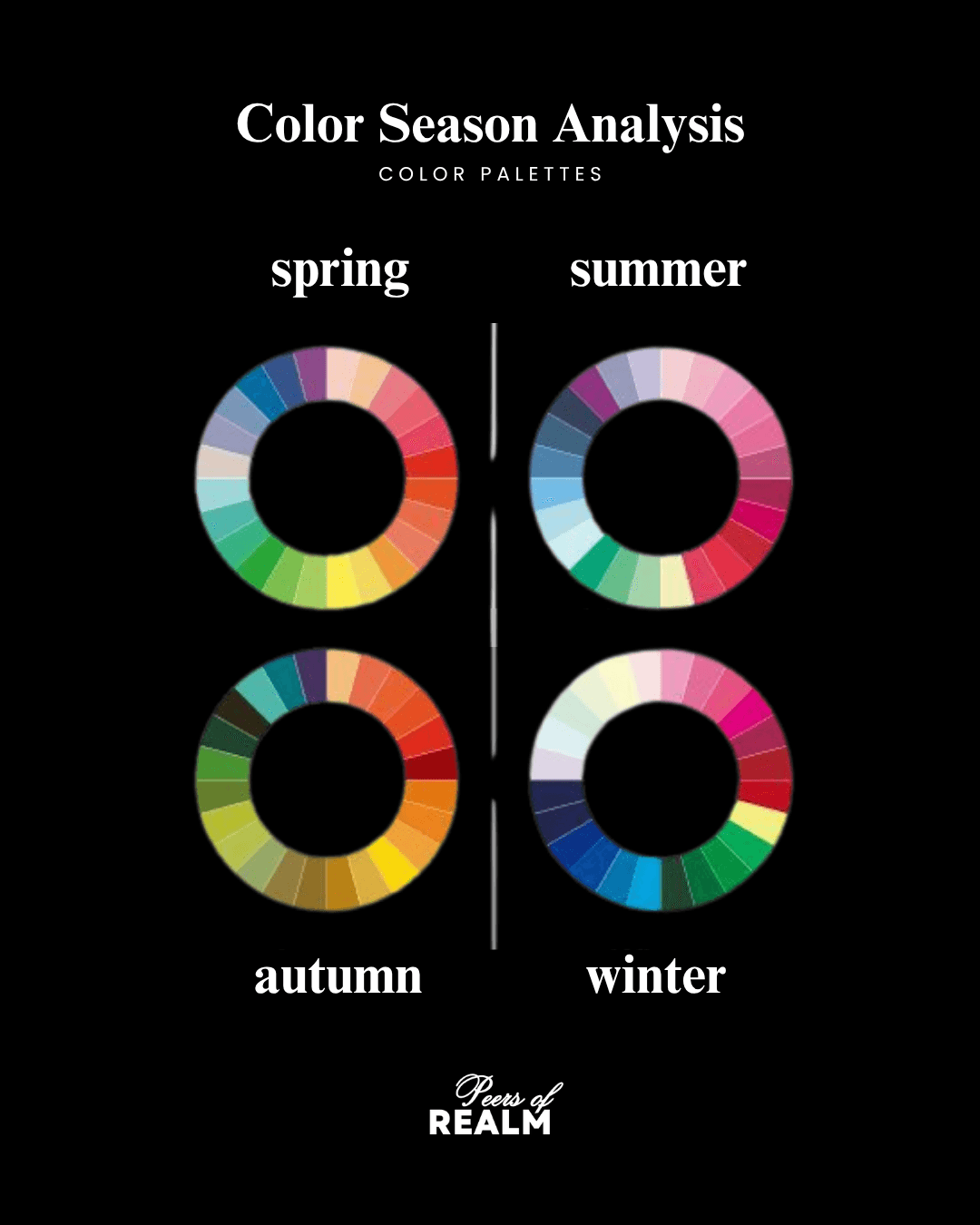The Guide to Color Season Analysis
Discover Your Signature Palette With Grace + Precision
Every woman has a natural color story—a unique blend of tones written into her skin, eyes, and hair like poetry.
Seasonal Color Analysis is the refined art of decoding that story, revealing the exact hues that make you look effortlessly radiant, pulled-together, and oh-so-you.
Knowing your color season is like unlocking your own luxury color palette.
It helps you curate a wardrobe, makeup bag, and personal brand that harmonize with your natural beauty—no more guessing, no more “meh” colors, just glow and confidence.
But finding your color season can feel a bit overwhelming. So in this beautifully curated guide, we’re going to walk you through it step by step—no jargon, just timeless chic wisdom.

How It Works: The Basics of Color Seasons
Think of yourself as a work of art. Like a painting, you have a natural palette—the specific tones in your skin, eyes, and hair. Seasonal color analysis simply matches that natural palette with a set of colors that enhance you instead of fighting you.
We do this by examining your features along three dimensions of color:
Hue (warm vs. cool)
Value (light vs. dark)
Chroma (soft vs. bright)
Let’s break them down in a way that actually makes sense…

I. Hue — Are You Warm or Cool?
Hue is the "temperature" of your coloring.
What we are really concerned with here is the hue’s undertones. The more yellow you add to a color, the warmer it becomes. The more blue you add to it, the cooler it gets.
Warm tones have a golden, peachy, or yellow undertone.
Cool tones lean towards blue, rosy, or ash undertones.
Ask yourself: Do I glow in gold or slay in silver? Does peachy blush light me up—or do I look fresher in cool pinks?
This tells us whether your best colors are warm, cool, or somewhere in the neutral zone.

II. Value — Are You Light, Medium, or Dark?
Value looks at how light or deep your coloring is.
Light value: Blonde/light hair, fair skin, light eyes
Dark value: Deep hair, rich skin, bold eyes
Medium value: Somewhere gracefully in between
Ask yourself: Is my natural contrast soft and airy, or bold and dramatic? Do pastels disappear on me or do they make me glow?
Your contrast level also plays a key role. High contrast? You might need bold, clear colors. Low contrast? Softer shades may suit you best.

III. Chroma — Are You Muted or Bright?
Chroma is the saturation of your coloring—aka how vivid or soft your natural tones are.
Bright chroma: Clear, striking features that pop in saturated color
Muted chroma: Softer, blended features that shine in gentle, greyed-down hues
Ask yourself: Do electric shades energize me, or do they overpower me? Do muted mauves or dusty blues flatter me more than vivid pinks or true reds?

🎨 The Six Color Aspects: Your Personal Formula
You have a setting on all three color dimensions—but one will always be your main character.
Your Primary Color Aspect
This is your most dominant trait—the color rule you must follow.
Warm
Cool
Light
Dark
Bright
Muted
You’ll need the most extreme version of this aspect. For instance, if you’re Warm, even neutral-warm colors may fall flat. You’ll thrive in the most golden, fiery, sun-drenched hues.
Your Secondary Color Aspect
This adds nuance. You still lean toward one side of the spectrum, but not all the way.
Examples:
Neutral-cool / neutral-warm
Medium-bright / medium-muted
This means you look best in colors that lean in a certain direction, but extreme versions may overpower you.
🌸 Your Tertiary Color Aspect
This one is more neutral—it adds a soft background note but isn’t critical. It’ll either be your value or chroma, and you’ll sit somewhere close to the middle.

Your Color Season = Your Signature Palette
Once we’ve mapped your three dimensions, we match you with your color season—a curated family of colors that reflect and enhance your natural beauty.
The right color season will:
✔️ Harmonize with your skin tone
✔️ Make your eyes glow without makeup
✔️ Elevate your wardrobe into instant elegance
Quick Note: Color Dimensions Are Intertwined
While we’re analyzing them separately, real-life coloring is fluid and connected.
For example:
Warm + light coloring often appears brighter
Cool + dark coloring often thrives in bolder contrast
Dark warm tones tend to be more muted
Light cool tones tend to be soft and ethereal
So as we go through the analysis, keep the big picture in mind. Your palette is not a limitation—it’s your divine design, darling.

Before we talk about which shades of chartreuse or blush will make you look like a goddess, let’s start with what really matters: your undertones.
And no, this has nothing to do with how light or dark your skin is. We’re talking about the temperature of your features — the secret language of warmth, coolness, depth, and clarity that defines your natural beauty and your Color Season.
Skin Undertones & Overtones
Let’s not get them confused:
Undertone is the quiet glow beneath your skin. It can be cool (blue or pink), warm (golden, yellow, peachy), or neutral (a soft blend of both).
Overtone is what you actually see in the mirror — from fair porcelain to deep espresso. It’s influenced by your ethnicity, sun exposure, and skincare, but it’s not what we’re analyzing here.
✨ A quick test:
If gold jewelry lights you up, you’re likely Warm (think Spring or Autumn).
If silver makes your skin glow and look crisp, you’re probably Cool (hello Summer and Winter).
If both look good? You're likely neutral, which opens the door to one of the more balanced seasons like Soft Autumn or Soft Summer.

Hair Undertones
Your hair is a big part of your seasonal puzzle. Look closely:
Warm hair has a sunlit glow: golden blondes, copper reds, honey browns. These hues belong to the Spring and Autumn seasons.
Cool hair is ashy, silvery, or deep espresso black — think of the misty tones of Summer or the dramatic contrast of Winter.
Red hair can be either: strawberry blonde and copper? Warm. Blue-red or dark auburn? Cool.
Neutral hair tones exist too — they’re softer, less vibrant, and often align with the Soft subtypes like Soft Summer or Soft Autumn.

Eye Undertones
Your eyes sparkle with clues:
Warm eyes: amber, hazel with golden flecks, warm green, or toasty brown. They come alive next to gold and belong to Spring or Autumn seasons.
Cool eyes: icy blue, steel grey, dark brown, or black. These eyes are magnetic with silver and belong to Summer or Winter.
Neutral eyes? A bit of both — muddled or soft shades that aren't clearly warm or cool — perfect for those in the Soft Summer/Soft Autumn category.
Pro tip: hold gold or silver next to your eyes. One will make them glow. The other? Meh.

Once you've identified your undertones — the golden glow of warmth, the crisp edge of coolness, or the soft balance of neutrality — you're ready to meet your Color Season.
But this isn’t just about slapping a label on your coloring. Oh no, darling. It’s about understanding how light, depth, temperature, and contrast dance across your features — and discovering the exact color harmonies that make you look lit from within.
The Seasonal Color Analysis system breaks down into four seasons — Spring, Summer, Autumn, and Winter — based on the natural rhythms of light and shadow in nature. Each season is further refined into three subcategories, giving us 12 color types total.
Dreaming of a wardrobe that reflects your power?
Download Your Free Timeless Style Blueprint—expertly crafted to elevate every look. Unlock the Ultimate Style Ritual Guide—designed to make you glow.
Color Season Types
Let’s explore the soul of each season, shall we?

Spring – Light, Warm, and Radiant
Keywords: Fresh, youthful, glowing, clear
Temperature: Warm
Contrast: Low to medium
Best colors: Light peach, coral, golden yellow, mint, aqua, warm ivory
Spring types have a luminous warmth, like the first morning sunlight kissing the earth. Your features are bright and delicate, never heavy or muted. Your skin may have a peachy or golden tone, your eyes sparkle like a fresh stream — green, topaz, warm blue — and your hair often has a golden or strawberry undertone.
Spring is for those whose coloring sings in clear, warm pastels and bright, cheerful hues — never muddy, never dark. Think of blooming tulips, citrus fruits, and sunrise skies. Your magic is in lightness and vibrancy.
Subtypes:
Light Spring – Shares softness with Summer, but with golden warmth
True Spring – The purest, warmest Spring expression
Bright Spring – Shares clarity and contrast with Winter, but stays warm

Summer – Cool, Soft, and Romantic

Keywords: Misty, elegant, gentle, refined
Temperature: Cool
Contrast: Low to medium
Best colors: Rose, mauve, powder blue, lavender, dove grey, cool taupe
If your beauty whispers rather than shouts, you might be a Summer. This season evokes the soft light of early dawn, with skin tones that lean rosy or cool-neutral, eyes in silvery blues, stormy greys or soft greens, and hair that tends to ash or muted brown.
Summer types are all about refined coolness and subtlety. No loud primaries here — your palette is delicate, like watercolor paintings or vintage Parisian fashion. You shine in cool, soft, and muted tones with a touch of romantic melancholy.
Subtypes:
Light Summer – Shares lightness with Spring, but keeps a cool, powdery feel
True Summer – Classic soft coolness, no warmth in sight
Soft Summer – Shares neutrality with Autumn, but stays on the cooler side

Autumn – Warm, Rich, and Earthy

Keywords: Spiced, grounded, golden, luxurious
Temperature: Warm
Contrast: Medium to low
Best colors: Rust, camel, moss green, mustard, burnt orange, espresso brown
Autumn is the season of richness and depth. Your features carry a smoky warmth, like candlelight flickering in a mahogany room. Your skin might be golden, olive, or deep caramel. Your eyes may be amber, dark hazel, or mossy green. Your hair radiates in hues of copper, chestnut, or dark golden brown.
You thrive in deep, muted, warm tones — like a forest in October. Jewel tones? Too icy. Pastels? Too pale. Autumn is about spice, texture, and depth — think antique gold, terracotta, olive oil, and aged leather. You were born to wear color like it's poetry.
Subtypes:
Soft Autumn – Shares gentle tones with Summer, but adds a warm filter
True Autumn – The most classic warm, muted palette
Deep Autumn – Shares intensity with Winter, but stays richly warm

Winter – Cool, Deep, and Striking

Keywords: Bold, clear, powerful, dramatic
Temperature: Cool
Contrast: High
Best colors: True black, pure white, cobalt blue, icy pink, emerald, cherry red
Winter types are visually unforgettable — your features carry icy clarity and vivid contrast. Skin tones often have a cool or neutral undertone. Eyes are sharp — icy blue, deep brown, charcoal grey. Hair tends to be dark: black, ash brown, or icy platinum.
You shine in pure, bold, and cool colors — not because they blend in, but because they mirror your commanding energy. Neon pink, jet black, arctic blue — these shades don’t overpower you, they match you. Winter is fashion week in New York, opera in the snow, diamonds on velvet.
Subtypes:
Deep Winter – Shares richness with Autumn, but with cool intensity
True Winter – Pure contrast and coolness, no warmth allowed
Bright Winter – Shares vibrancy with Spring, but keeps its cool

Wearing your seasonal palette isn’t just about looking good — it’s about resonance.
The right colors create harmony between your external beauty and your inner energy. They make your eyes brighter, your skin smoother, your confidence louder — without a drop of makeup.

A curated Digital Atelier.
CATEGORIES
Self Mastery
Fashion & Style
Lifestyle Curation
Digital Realm
All Rights Reserved.







